Page 8 <previous page> <next page>
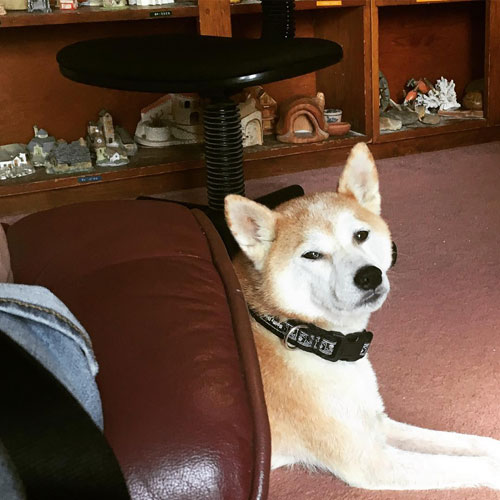
Huck the helpful!
by Malley Bragg Heinlein - March 17 | Clean Run, reprinted with permission.
I have had three Shibas—Houdini, Huck, and Tiger Lily—and I trained two of them for companion sports. But I never knew the breed was hard to train until I started showing them at companion dog shows where there were spectators. People who have heard of Shibas, and also many people who own them as pets, often tell me that they wouldn’t even consider trying to train them in dog sports.This didn’t jive with my experience with the breed at all. I’d owned a wide range of different breeds and my first Shiba, who I got in 1994, was the easiest dog I’d ever had. I just trained him as a pet, to do the usual things we needed to have a happy life together. He learned fast and things stuck. He wasn’t too needy, but was always aware of where I was and what I was doing. His innate dignity and quiet, but deep loyalty made me feel a special kind of love that I never had experienced before from a dog, winning my heart to the breed forever.
People are both interested and surprised when I tell them that Shibas are hunting dogs that have been domesticated for thousands of years, that they are descended from the now extinct Japanese wolf, and that they are still used in Japan to hunt both large and small game.They are sent out to find, flush, corner, and hold prey for the hunter who follows them and shoots the prey.
When we got a new puppy after my first Shiba passed away, the same breeder sent us a three-month-old boy. I’d been injured in a car accident the year before, and was destined to have several surgeries, so we thought it might be a good idea to take him to training classes to help him adapt to my different conditions. We were fortunate to find Nancy Banask, a trainer who is active in agility. She uses positive reinforcement training methods, and Huck took to everything right away, breezing through his classes. Nancy encouraged us to enter her competition agility classes, which she held in her back yard in the summer.
After a couple of summers when I had healed up and Huck finally stopped chasing squirrels, we entered our first agility trial. We earned first place, just as we had done in our beginner obedience and rally events. Until then we had only done agility in Nancy’s yard. Class was on regulation equipment, but we had never been in a real agility ring, or even done a run-through in an agility facility.
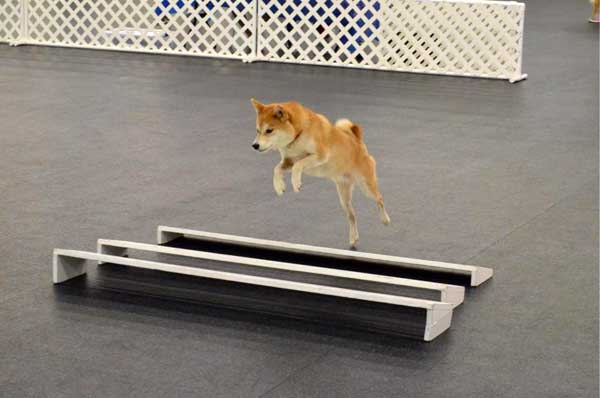 Wilson photo
Wilson photo
I’ve often wondered what people needed to know about the breed to help them to appreciate its gifts and begin to have more success with them.Their profile as a dog ideally suited to jumping and running, to being trusted to work at a distance from their hunting masters, combined with their bravery and problem solving intelligence, should make them perfect partners for many people. And Shibas would benefit from being taken to classes if their owners thought it was even a possibility. In my research for this article, I talked to breeders, trainers, and a few of the top agility Shiba handlers and asked them to share some of their experiences and advice.
To better understand their mindset, I spoke with Molly Sumridge of Kindred Companions LLC, a New Jersey based professional trainer and writer who in her practice has trained many different types of dogs. She owns and shows mainly primitive breeds in obedience and rally, including Shibas and New Guinea singing dogs. She’s currently writing a book about working with primitive dogs, and she outlined the main differences in the development of these dogs as compared to some of the more traditional Western breeds that are popular agility dogs.
She explained that those Western breeds have been selectively bred for the past two hundred years to carry out the commands of their humans without question.“These breeds have a genetic predisposition to follow instructions from humans to the point that some of these dogs quiver in anticipation of being told what to do.They require guidance to survive, and if tomorrow all human beings disappeared, many of them would die without someone to make decisions for them. More primitive types of dogs are predisposed to be independent thinking. A boar hunting Shiba Inu is going to be able to chase that boar, bark at that boar, and it’s going to attack that boar in unison with its fellow hunting dogs and it’s going to be able to make those decisions on its own. If it were to stop and take instruction, it would probably die. For thousands of years that coding, that instruction manual, has been bred into that dog’s brain and emotional make-up. So when we are asking a dog with that kind of coding to perform a behavior, the first question that comes to him is, ‘does that benefit me or does that put me at risk?’ The herding dog jumps because he is supposed to, you can tell the wiring says ‘human says jump so I jump.’ But with the Shiba, I say jump, and he says, ‘why?’ and if I can give him a good enough why, he will participate. And that is so reinforcing for me and so valuable, that it is worth it.”
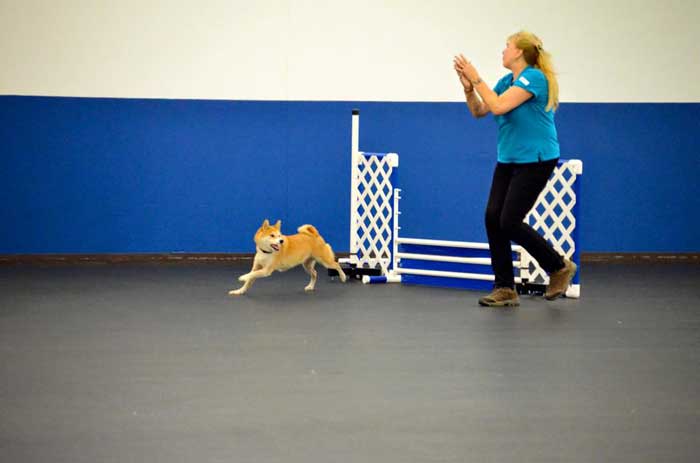
Malley and Huck - Veronica Wilson Photo.
All of the people who I know who are successful with their agility Shibas acknowledge they are different than other types of dogs they have owned and trained. They all got started in agility with some kind of early training in basic obedience.Their dogs all rebel against traditional training methods that don’t take into account their innate intelligence and self-respect. Some even had early behavior issues, like anxiety or aggression, or would shut down from multiple attempts by previous owners to force behaviors.
Amy Ripepi
Amy began in agility on the recommendation of a trainer as a possible diversion for her first Shiba’s severe anxiety. Her boy Sumo took to agility right away. He is now retired and is a confident dog in any environment. Her rescue girl Kiko also has anxiety, but through training she now walks calmly though crowded show places and runs her courses with total focus on Amy. Kiko got her MACH2 in November 2016.
Joni Andrews
The newest agility handler I spoke with, Joni, began her journey with agility because her dog had behavior issues she had never encountered in other dogs that she had trained as pets. She researched the breed to see what to expect, but after a year of frustration, she and her husband admitted defeat. Joni and Shelby went into beginner obedience, did homework every day, and started to have immediate small benefits. Then they found themselves in intermediate obedience and agility. Shelby had problems with drive, jumping, and had no recall. It took about a year and a half for the recall to come, doing work on the flat, watching other dogs run and jump.The classes wore her out mentally and physically, her whole personality gradually changed, and over time Shelby “became the best heart dog a person could ask for.” Once uncomfortable socially, she’s now very social with other dogs off leash. After two years of training, Joni was encouraged by her mentors to build her own confidence and compete. Seventeen months after their first Novice A agility run, Shelby got her MACH title.
Karen Groth
Karen has a similar story. She adopted her Shiba Sheena as a rescue puppy and then found she had to nurture her back to health from parvovirus. Karen’s previous dog had been a Jack Russell Terrier, but she was enchanted by the Northern look of the Shiba, which reminded her of a small Siberian Husky. She found an obedience trainer and judge who used to raise Shibas and began Sheena in basic class. At her trainer’s recommendation, she started agility classes, and after six months entered Sheena in the 2003 National Shiba Club of America Performance trial, where she ran clean on her second time in the ring, at the larger all-breed trial sponsored by the club, and took first place in Novice A Jumpers. Sheena had a tough Shiba attitude which only increased with scolding, so Karen found more creative ways to handle her. Her early issues were mainly shyness of the judge and doing weave poles and table, not unusual problems for any new handler with any breed of dog. She worked through those with advice from other handlers on her training team at home using sends and games, with tons of treats and enthusiastic praise. Sheena is still playing, although she retired recently with a MACH3, some points shy of her fourth MACH, having competed in two AKC National Agility Championships, and having made the top twenty at a State of Ohio trial. Karen currently runs her Shiba male, Yeungling.
Sandra Tung
A first-time dog owner, Sandra got her Shibas Maluko and Koji as older dogs from a breeder. Maluko was a five year-old brood bitch, and Koji was a year and a half when Sandra took them home. She was encouraged by a friend to take them to obedience and then on to rally and agility classes.They both began to complete and title in different sports. Koji got his first MACH quickly and now has MACH3 and multiple titles in nose work, obedience, rally, coursing ability, and barn hunt, where Sandra is now a judge. Sandra got another Shiba puppy, Taiyo, and also an Aussie. She continues to work Maluko and all of her dogs in most of the companion sports. She and Koji are well on their way to another MACH.
Julie Jones
Julie fell in love with the Shiba’s “big dog presence in a com- pact little body,” and got her first one as a pet in 2000. She saw her first agility trial at the Rose City Classic in 2004 and as she puts it,“was completely hooked.” Her first Shiba, Mika, was four years old, so she got another puppy from her breeder. Toshi was a return, who was skittish and a runner, so they could only do agility where it was completely safe. Julie had to check for escape routes and post a friend to spot him.They competed solely in CPE in the beginning. He got his CACH, aided by “a whole group of friends working as a team event keeping him in the ring.” (Toshi is now back running in AKC Masters Agility.) Hooked on agility, and also on the Shiba breed, Julie had gained a better idea of what she needed in a dog to do both, and looked for a puppy to combine her loves. In 2008, she got Kado, who had a different mindset. He’s friendly, lives well with other Shibas and Julie’s other pets, including dogs, cats and rabbits. She was able to train “a rock solid start line stay regardless of what’s going on.” Kado is devoted to Julie, who feels their strong relationship is the source of Kado’s strong performance in the ring. She is very careful to treat him and reward him with praise and love, regardless of what transpires on a course. In return she notices he is focused and careful to complete his obstacles with precision at trials. He knows and loves his job and the deep relation- ship that has developed has kept him working loyally with her. Kado has now got MACH13, and is still having a great time running.
Eunice and Mark Giles
Eunice and Mark of Nozomi Shibas in New Hampshire have been developing their own line of performance Shibas. They have achieved multiple titles in different venues with their dogs, including AKC, CPE, and Teacup Agility. Their girl Buttercup has been the only Shiba so far to earn both a breed championship and a MACH. They try every one of their dogs in agility, and encourage their pet people to at least try some kind of performance with their pups. Their dogs are at the top of the Shiba reports in AKC and CPE, where Mark is also a judge. Sarah S. Carson, who is Eunice’s sister, also judges CPE agility and successfully runs Nozomi dogs.Their daughter, Norah Giles, has been brought up in the sport since she was a little girl, and at age thirteen she handles her bitch Zoe with enviable ease and elegance. Most recently, they’ve had several major milestones with their dogs.
Eunice got a MACH with her boy James at the 2016 Shiba Companion Sports Event. Wilson Photo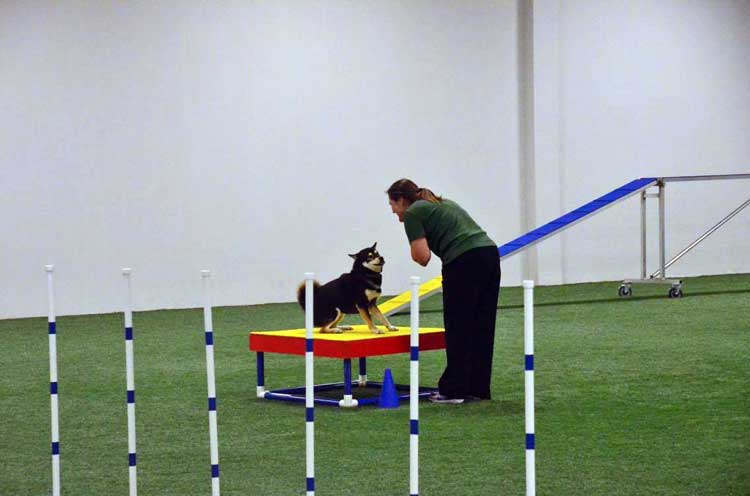
At the 2016 Thanksgiving Cluster in West Springfield, Massachusetts, they showed five of their dogs in obedience, conformation, and agility, with Mark finishing two MACHs in the same Jumpers class.Their young female Diamond got her first MACH, and their boy Westley became the second Shiba to achieve a MACH4, with Kado being the first.
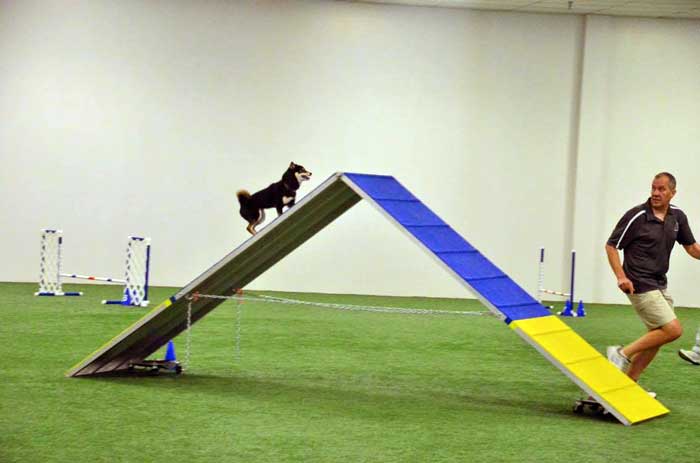 Wilson
Wilson
Looking for a Shiba Puppy to Do Agility?
A Shiba is typically long lived, from 14 to 16 years or longer, and can be your working partner for most of that life, achieving a depth of understanding that increases with age. Genetics play a huge part in stamina, temperament, and longevity, so look for a breeder with a history of breeding for sound structure, and who has many generations of health testing available. A Shiba should have overall balance, not too big, too small, with a 10 to 11 ratio, only slightly longer than tall, with good amount of leg underneath, without a heavy body. Look for some structural angulation in the rear, as they are meant to move quickly and make fast turns.They also need plenty of forearm above the elbow so they can stretch out for jumps. Remember, they are fearless and have high energy, but a new agility puppy should not be allowed to play hard with adult dogs. Absolutely no body slamming, rough play, or going up and down stairs, until their growth plates have closed at around eighteen months.
Even with good structure, Shibas can be easily mishandled and have to be maintained.Their front structure makes them weave differently, and it’s hard on their sacrum and shoulders. Exercises like ball work are essential conditioning, and chiropractic adjustments every four to six months help maintain their athletic ability. Swimming is also great training, if you are careful how you introduce it to them, as not all Shibas love the water. Amy takes her dogs to do the under water treadmill once a week, which she gradually conditioned them to like with high value treats over several weeks. Canine massage is good for touch-sensitive older dogs, but also for young puppies, too, as a way to relax them and also to help detect any developing problems.
Most importantly, no matter how charmingly they beg, be very careful not to over feed them. They typically should weigh from 17 to 25 pounds, depending upon their height.
Once you get your Shiba engaged with agility, you have activated his ancestral instinct and he can be as reliable and consistent as any other agility dog. In the Shiba’s mind, he’s not an extension of your will, working for the pleasure of being commanded, but a separate being who has come to trust and enjoy performing beside his companion human, and that feels like a great compliment. They are funny and wise at the same time, can be mischievous in a way that they can always be forgiven by charming their owners.
Leland Perry is an example of someone who feels this way. He was one of the first people to title a Shiba in AKC obedience with his boy Tsunami, and also one of the first 20 to title a Shiba in AKC agility. He’s currently running Takibi, a young Nozomi dog, and he treasures this relationship on and off the course as something very unique and rewarding. He’s had great success with his Aussies, too, who he adores, but also always wants to run with a Shiba.
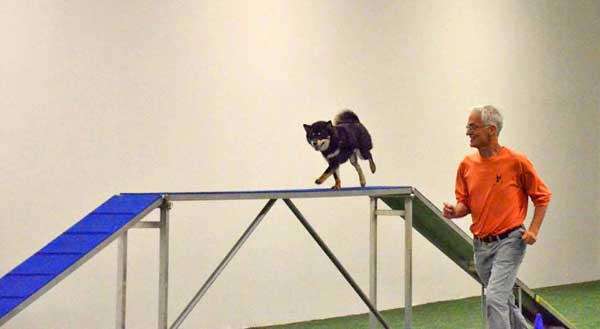
Leland & Takibi, Wilson photo.
While it takes more to engage them, the long-term results of training with a Shiba are a loyal partnership that is consistent, with much potential for personal growth. Handlers say they have become more creative, less self-conscious, and freer in self-expression in the ring. You have to be thinking ahead to focus them and keep it fun, you must engage them with “goofy turned on energy,” as Karen Groth puts it. You have to watch yourself when they push your buttons while they decide what they will offer you, but you can never force them or they lose respect for you and shut down. Because their instincts are always concerned with their personal safety, they need to be conditioned to the agility environment from an early age.Whenever they got to a new performance or class location, it’s important to walk them around it to familiarize them with the area. This also holds true for any changes in a space they have become accustomed to. Once you have earned their trust, they are counting on you to work with them regularly, to treat them fairly and to keep them safe.
The “stubborn Shiba” reputation has its source in their unique intelligence and dignity that results in a refusal to be forced. If you want a deep experience of communicating and bonding with a dog whose every performance is a test of, or a testament to your consciously forged partnership, you are ready to embark on a deeply rewarding journey into yourself alone with the loyal and spirited soul of your dog.And you can have a lot of fun and win a lot of titles along the way!
Note:
The National Shiba Club of America has an annual Shiba Performance Trial, held at Countryside Agility in Erie, Pennsylvania, usually around the third week of September. Handlers come from all over the country.The spirit of support and the mentor- ing that happen there are definitely worth the trip for anyone with a Shiba.You can find more information about it on the NSCA website - www.shibas.org.
Malley Bragg Heinlein has been in love with Japanese dogs since 1985, when she got her first Akita. She’s had Shibas since 1994, and has been training and showing in companion sports since 2009. She has a Facebook group called Shiba CAN, Too! to help people find information about how to train their dogs and post their accomplishments with them. She’s developing a website, shibacantoo.com, to encourage the breed’s active participation in their people’s lives. You can also find more information on training primitive dogs on Molly Sumridge’s website.
Malley is a member of our Rip Van Wrinkle Basenji Club. She's judged several of our Match Shows.
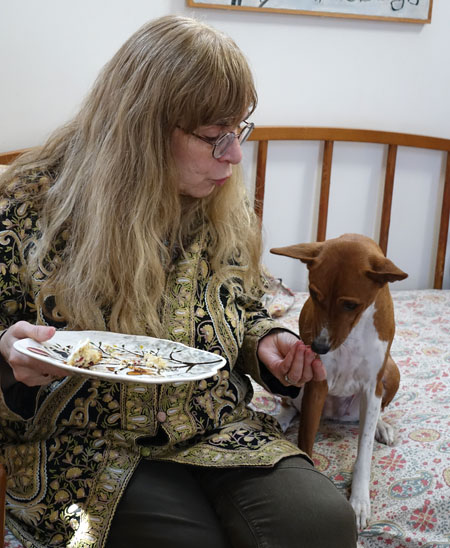 Wrinkler Brunch, with Scarlet
Wrinkler Brunch, with Scarlet
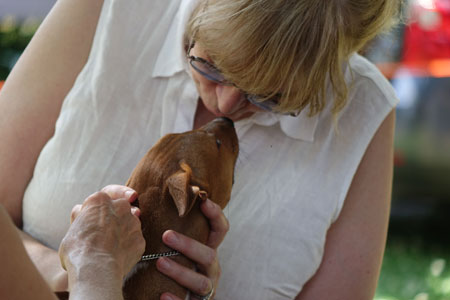 How to judge, Malley style.
How to judge, Malley style.